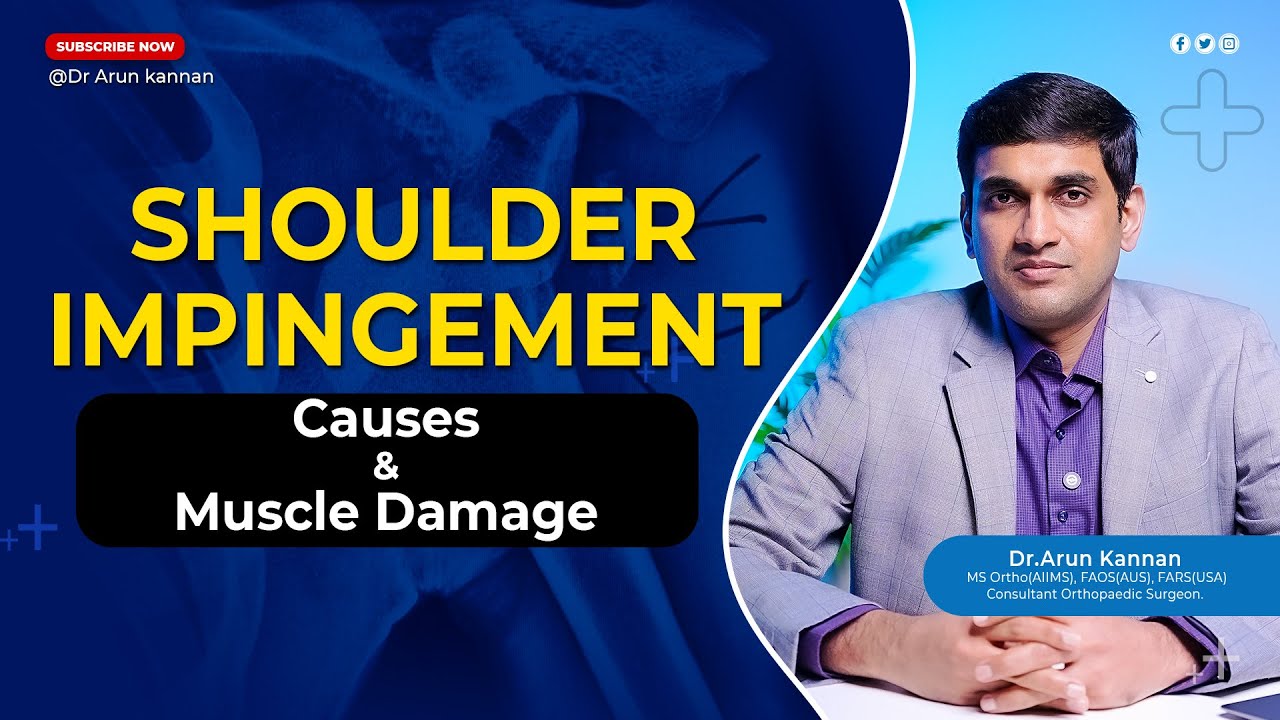 8 August, 2025
8 August, 2025
Shoulder Impingement: Why It Happens & Muscle Damage Explained | Dr. Arun Kannan
The shoulder is one of the most remarkable joints in the human body, providing an incredible range of motion and flexibility that allows us to perform countless daily activities—from lifting and reaching to throwing and rotating. However, this freedom comes with its own set of vulnerabilities. One common and often painful condition that affects the shoulder is shoulder impingement, a problem that involves muscle damage and restricted movement. In this comprehensive guide, we explore the causes, underlying anatomy, symptoms, diagnosis, and treatment options for shoulder impingement, drawing insights from Dr. Arun Kannan, a leading orthopedic surgeon based in Chennai.
Understanding Shoulder Impingement: What Is It?
Shoulder impingement occurs when the tendons of the rotator cuff muscles become irritated and inflamed as they pass through the narrow space between the acromion (a bony projection on the scapula) and the head of the humerus (the upper arm bone). This condition often leads to pain, weakness, and decreased range of motion in the shoulder.
The shoulder joint is a ball-and-socket joint, with the “ball” being the head of the humerus fitting into the “socket” of the scapula. This design allows for maximum movement but also requires a precise balance of muscles and tendons to keep the joint stable and functioning smoothly.
Dr. Arun Kannan explains that the rotator cuff muscles—key players in shoulder movement—are particularly vulnerable to impingement because they operate in a tight space. When this space becomes compromised due to inflammation, anatomical variations, or repetitive use, the tendons can rub against the bone, causing friction and damage.
The Anatomy Behind Shoulder Impingement
The rotator cuff is a group of four muscles that surround the shoulder joint and help stabilize and move the arm:
- Supraspinatus – assists with lifting the arm
- Infraspinatus – helps rotate the arm outward
- Teres minor – also assists in outward rotation
- Subscapularis – rotates the arm inward
These muscles originate on the scapula and attach to the humerus via tendons. The space between the acromion and the humeral head is called the subacromial space. When this space narrows, the tendons can get pinched or “impinged,” leading to inflammation, pain, and damage.
Why Does Shoulder Impingement Happen?
Several factors can contribute to the development of shoulder impingement. Dr. Kannan highlights the following key causes:
- Anatomical Variations: Some people have a naturally narrower subacromial space or bony spurs on the acromion that reduce space for the tendons.
- Repetitive Overhead Activities: Sports like swimming, tennis, or occupations involving repetitive overhead work can cause chronic irritation of the rotator cuff tendons.
- Muscle Imbalance or Weakness: Weakness in the rotator cuff or shoulder blade muscles can alter shoulder mechanics, increasing the risk of impingement.
- Age-Related Degeneration: Tendons can wear down over time, making them more susceptible to injury and inflammation.
- Inflammation and Swelling: Conditions such as bursitis or tendinitis can cause swelling in the subacromial space, reducing room for the tendons.
Understanding these causative factors is crucial for both prevention and treatment. Identifying the underlying reason helps tailor the approach to each individual patient.
How Does Muscle Damage Occur in Shoulder Impingement?
When the rotator cuff tendons are repeatedly pinched or compressed in the subacromial space, they undergo microtrauma. This irritation can lead to inflammation (tendinitis) and, over time, degeneration or partial tears in the tendons.
Dr. Kannan explains that the process starts with friction and rubbing between the tendons and the bony structures. This constant irritation damages the tendon fibers, leading to pain and weakening of the muscle-tendon unit.
In some cases, the damage may progress to partial or even full-thickness tears of the rotator cuff tendons. This not only causes pain but also impairs shoulder function, making it difficult to lift or rotate the arm.
Muscle damage from impingement can also trigger inflammation of the bursa (a fluid-filled sac that cushions the joint), further narrowing the space and worsening symptoms.
Recognizing Shoulder Impingement: Warning Signs You Shouldn’t Ignore
Early recognition of shoulder impingement is key to preventing further damage and ensuring effective treatment. Here are some common symptoms and warning signs to watch for:
- Shoulder Pain: Typically felt on the outside or front of the shoulder, especially during overhead activities.
- Weakness: Difficulty lifting or rotating the arm due to muscle weakness caused by tendon damage.
- Limited Range of Motion: Reduced ability to move the shoulder freely without pain or discomfort.
- Night Pain: Pain that worsens at night or when lying on the affected shoulder.
- Clicking or Catching Sensation: Feeling of the shoulder “catching” during movement, indicating tendon irritation or damage.
Ignoring these symptoms can lead to worsening tendon damage, chronic pain, and even frozen shoulder (adhesive capsulitis), a condition where shoulder movement becomes severely restricted.
Diagnosing Shoulder Impingement: How Doctors Identify the Problem
A thorough clinical examination combined with imaging techniques is essential for diagnosing shoulder impingement accurately. Dr. Arun Kannan emphasizes that an orthopedic surgeon will typically follow these steps:
- Medical History: Understanding the onset of symptoms, activities involved, and any previous injuries.
- Physical Examination: Assessing range of motion, strength, and specific tests to reproduce impingement symptoms.
- Imaging Studies: X-rays to evaluate bone structures and rule out bony spurs or arthritis; MRI to assess soft tissue damage including rotator cuff tears and inflammation.
These diagnostic tools help differentiate shoulder impingement from other causes of shoulder pain such as arthritis, frozen shoulder, or nerve impingement.
Treatment Options for Shoulder Impingement
The approach to treating shoulder impingement depends on the severity of symptoms and the extent of muscle damage. Dr. Kannan outlines a stepwise treatment plan that includes conservative management, physical therapy, injections, and surgery when necessary.
Conservative Treatment and Physical Therapy
Most patients with shoulder impingement respond well to non-surgical treatment. The primary goals are to reduce inflammation, relieve pain, and restore muscle strength and shoulder function.
Key components include:
- Rest and Activity Modification: Avoiding aggravating activities, especially repetitive overhead movements.
- Anti-inflammatory Medications: Nonsteroidal anti-inflammatory drugs (NSAIDs) can help reduce pain and swelling.
- Rotator Cuff Strengthening Exercises: Targeted exercises to improve the strength and endurance of the rotator cuff muscles, which stabilize the shoulder joint.
- Shoulder Abduction Exercises: Strengthening the muscles responsible for lifting the arm sideways.
- Stretching and Range of Motion Exercises: To maintain and improve flexibility and prevent stiffness.
Dr. Kannan stresses the importance of a well-structured rehabilitation program. Initial focus is on improving muscle power and reducing pain, which accelerates healing of the damaged muscle and tendon tissues.
Injections for Shoulder Impingement
In cases where inflammation is significant and pain persists despite conservative measures, corticosteroid injections into the subacromial space can provide relief. These injections help reduce swelling and pain, allowing patients to participate more effectively in physical therapy.
However, injections are typically used judiciously, as repeated steroid use can weaken tendons over time.
Surgical Treatment: Arthroscopic Shoulder Surgery
When conservative treatment fails to relieve symptoms or when there is significant tendon damage such as large rotator cuff tears, surgery may be required. Arthroscopic surgery is a minimally invasive procedure that allows the surgeon to:
- Remove bony spurs or inflamed tissue that reduce the subacromial space
- Repair torn rotator cuff tendons
- Clean out inflamed bursa or damaged tissue
Dr. Kannan notes that less than a small section of patients with shoulder impingement require surgery. However, when surgery is performed, it has a high success rate, with more than 90% of patients experiencing significant pain relief and improvement in shoulder function.
Post-surgical rehabilitation is critical to regain full muscle strength and joint mobility. A dedicated exercise program must be followed to maintain the gains from surgery and prevent recurrence.
Preventing Shoulder Impingement: Tips for Healthy Shoulders
Prevention is always better than cure, especially for a complex joint like the shoulder. Here are some practical tips to reduce the risk of shoulder impingement, based on expert advice:
- Maintain Rotator Cuff Strength: Regularly perform strengthening exercises to keep the shoulder muscles balanced and strong.
- Practice Good Posture: Poor posture can alter shoulder mechanics and increase impingement risk.
- Avoid Repetitive Overhead Movements: Take breaks and modify activities that involve frequent arm elevation.
- Warm-Up Properly: Before physical activities or sports, warm up the shoulder muscles to prepare them for exercise.
- Listen to Your Body: Early shoulder pain should not be ignored. Address symptoms promptly to prevent progression.

